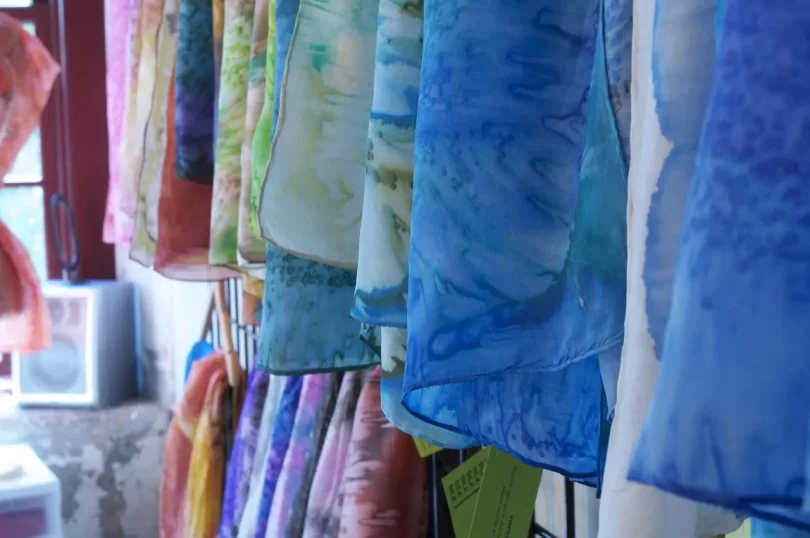Scarves have long been used as practical accessories to express individuality, showcasing elegance and culture. This tradition is deeply ingrained in Italy, especially in the Como region, where generations of silk artisans have honed their craft. Many Italian scarf producers are now fusing sustainability with legacy by modifying age-old techniques to satisfy contemporary environmental regulations and reshaping how we view womens Italian scarves and their place in modern fashion.
Silk Craftsmanship Rooted in Italian History
The silk business in Northern Italy’s Como area is well-known worldwide. For many years, local mills, many of which are family-run, have focused on producing silk. These workshops emphasize small-batch production, frequently utilizing age-old weaving methods and ancient looms, ensuring each piece is a valuable addition to your wardrobe, embodying luxury.
High-quality silk from responsible suppliers is used to make each scarf. For example, Elizabetta emphasizes its dedication to utilizing only Italian-made silk, guaranteeing traceability and compliance with European labor and environmental regulations.
Integrating Sustainability into Tradition
Traditional textile settings are increasingly adopting contemporary, eco-friendly approaches. Many artisan mills now choose certified non-toxic dyes, such as those with the OEKO-TEX® Standard 100 accreditation. These soft colors lessen skin irritation and their adverse effects on water systems, which is crucial for clothing worn near the body, respecting nature.
Production still heavily relies on manual operations in many workshops. In addition to maintaining local textile expertise, this promotes a less carbon-intensive substitute for highly industrialized processes. While not all women’s scarves are hand-loomed, prioritizing quality over quantity lowers waste and increases durability.
Ethical Labor and Local Workshops
Some brands, like Elizabetta, work directly with tiny, local mills instead of outsourcing production to large manufacturers. These workshops foster long-term employment and the maintenance of specialist skills by offering safe working conditions and fair compensation.
Many firms’ local and family-run structure reflects wider social ideals anchored in continuity and community, even though not all teams are managed by women.
Design Inspired by Seasonality
Seasonal signals are frequently used in Italian scarf patterns. While spring and summer designs may have pastel tones or light flowery motifs, fall collections could include richer hues like ochre, burgundy, and orange. Although the design process may also include digital modification for contemporary printing processes, many patterns are based on regional art or traditional Italian motifs, featuring unique designs.
The ultimate result is a combination of form and function, scarves that go well with various outfits and seasons.
Types of Scarves and Their Uses
Different scarf shapes serve different purposes, and each lends itself to specific styles and seasons:
| Scarf Type | Description | Common Uses | Best Seasons |
| Bandana | Small square | Tied around the neck, head, or bag handle | Year-round |
| Long Scarf | Rectangular shape | Draped or looped | Fall & Winter |
| Shawl | Larger, more coverage | Worn over the shoulders, formal wear | Spring & Fall |
| Wrap | Medium to large, versatile | Used as a top, belt, or bag accent | Spring & Summer |
| Wool Blend | Heavier, cozy | Winter layering | Winter |
This variety supports versatility in wear, whether for warmth, layering, or aesthetic appeal, allowing for an air of sophistication.
Scarves and Sustainable Fashion
Purchasing durable accessories helps reduce the environmental impact of fashion. When properly maintained, a high-quality scarf may last for many years. Scarves made with care and attention to detail encourage the concept of thoughtful consumerism, making them a perfect gift in contrast to things driven by trends.
Many eco-friendly scarf companies also reduce packing waste. Commonly used reusable boxes or fabric bags provide a sophisticated appearance without requiring extra resources.
The Journey of Italian Silk: From Mulberry to Masterpiece
To appreciate silk’s worth, one must know where it originates from. In Italy, particularly in the Como region, ethically bred silkworms fed mulberry leaves and other plants are frequently the first step in manufacturing silk. Every stage, from gathering the cocoons to spinning the threads, has its roots in custom and is increasingly influenced by environmental responsibility in every creation.
Why Choosing Quality Scarves Matters in a Fast-Fashion World
Since fashion trends are changing more quickly than ever, intentionally and well-made scarves are unique. Selecting classic, well-made items encourages long-term enjoyment over fads, slow fashion, and waste reduction, no matter the date.
FAQs
1: Do silk scarves work well in cold climates?
Yes, because of its ability to regulate temperature, silk is appropriate for layering during colder months, lasting two days of wear.
2: How should a silk scarf be maintained?
Choose professional dry cleaning or gently wash it in cold water with detergent. Avoid twisting or prolonged exposure to direct sunlight to maintain its beautifully crafted form.
3: What is an eco-friendly scarf?
Natural textiles like silk, certified non-toxic colors, and energy-efficient and waste-reduction techniques are essential components that may vary in their application.
4: Are these scarves made in large quantities?
Not at all. Small, regional mills that make scarves in small numbers are partnered with brands such as Elizabetta.
5: Are there any unconventional uses for a silk scarf?
Yes. Silk scarves can be framed as textile art or used to wrap presents or adorn luggage.
Conclusion
Though modest scarves symbolize a broader movement toward ethical fashion that honors traditional artistry and modern sustainability, they also enrich our lives. Whether choosing an Italian-crafted scarf or iconic pieces from heritage houses like Burberry, selecting items made with environmental care means supporting a system prioritizing quality, cultural legacy, and responsible production.







